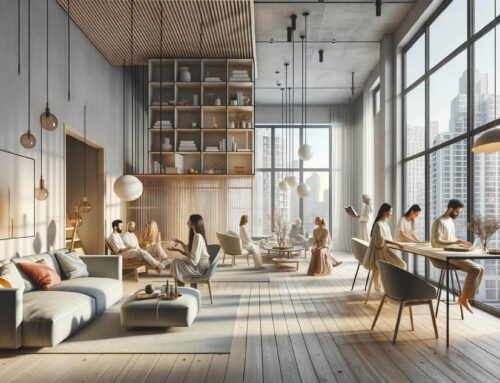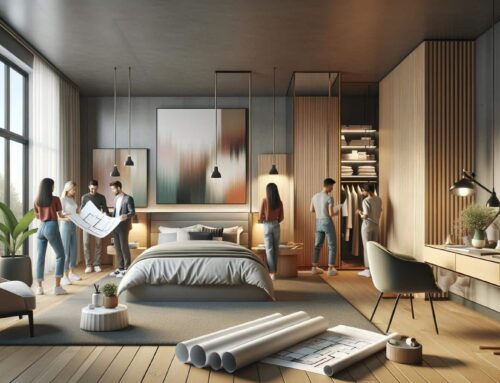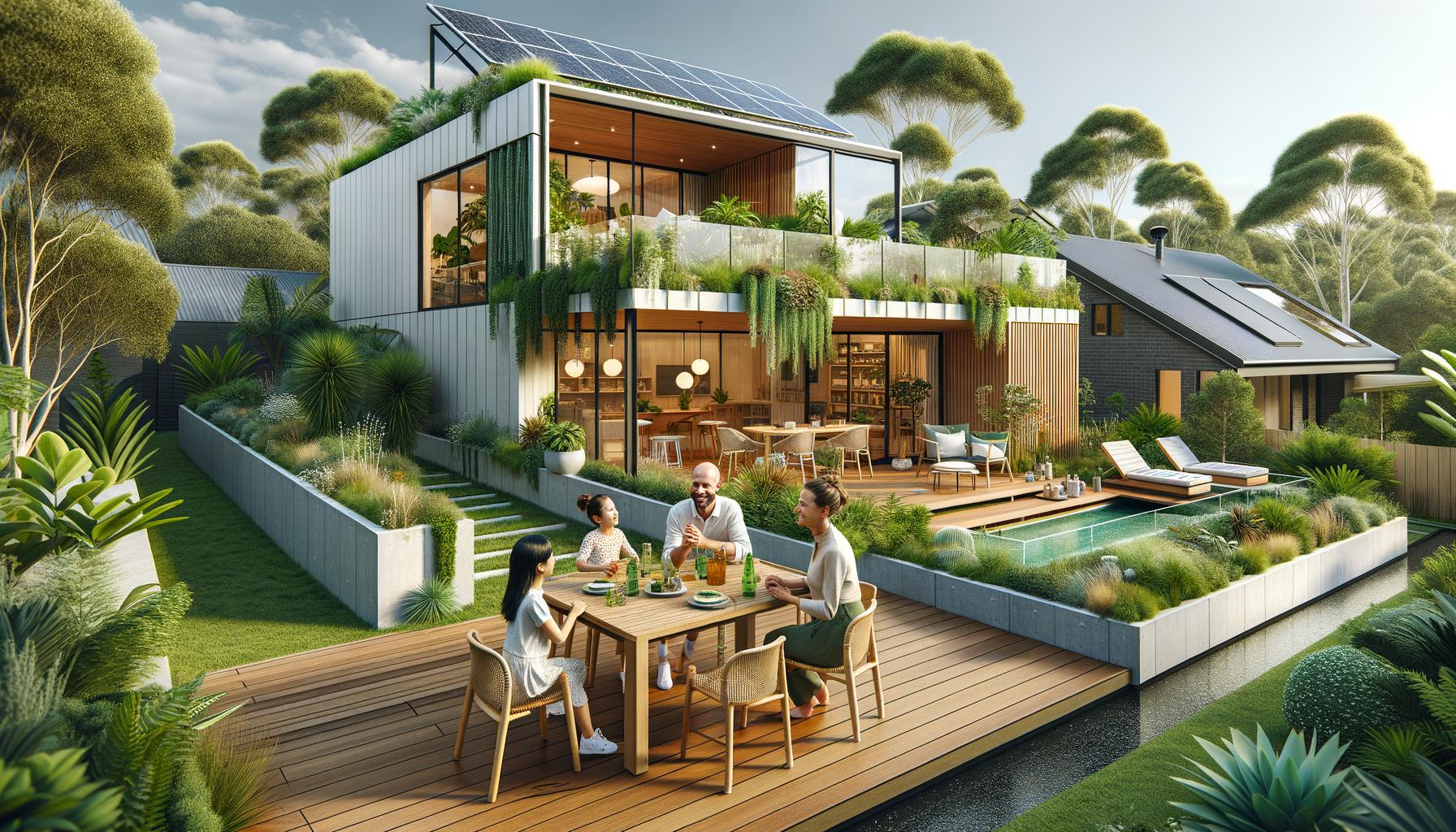
At Home Owners Association, we’ve witnessed a surge in interest for Australian sustainable homes. The demand for eco-friendly living spaces has never been higher, with homeowners seeking ways to reduce their environmental impact and energy costs.
In this blog post, we’ll explore the latest design trends and practical tips for creating sustainable homes in Australia. From energy-efficient materials to smart home technology, we’ll cover everything you need to know to make your home more environmentally friendly.
Key Features of Sustainable Homes in Australia
Energy-Efficient Building Materials and Insulation
Sustainable home design in Australia has transformed over the past decade. The trend towards eco-friendly housing solutions continues to grow, offering both environmental benefits and long-term cost savings for homeowners.
Energy-efficient building materials and insulation form the foundation of sustainable home design. The Australian Bureau of Statistics reports that homes with proper insulation can cut energy consumption by up to 45%. Double-glazed windows stand out as an excellent choice, reducing heat loss by up to 30% compared to single-glazed options. For insulation, we recommend products made from recycled materials (such as cellulose or sheep’s wool), which provide superior thermal performance while minimising environmental impact.
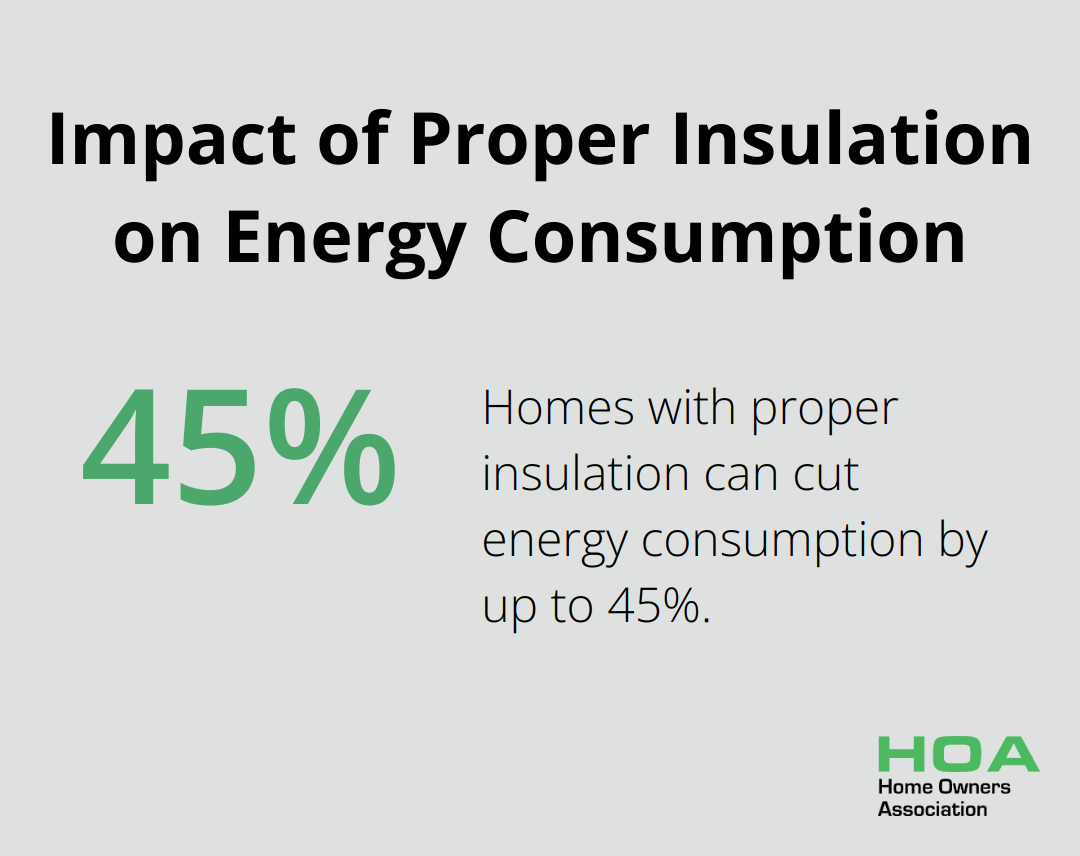
Solar Power and Energy Storage
Solar panel installation has skyrocketed in Australia, with 2023 seeing rooftop photovoltaic (‘PV’) installations surpass a total of 20 GW installed capacity. To maximise solar power benefits, we suggest pairing your system with a battery storage solution. This combination allows you to store excess energy generated during daylight hours for use at night or during peak demand periods, potentially slashing your reliance on the grid by up to 80%.
Water Conservation Techniques
In drought-prone Australia, water conservation takes centre stage. Rainwater harvesting systems can collect up to 100,000 litres of water annually for an average-sized roof in many parts of the country. This harvested water serves multiple purposes: irrigation, toilet flushing, and laundry, significantly reducing mains water consumption.
The installation of water-efficient fixtures also plays a crucial role. Low-flow showerheads and dual-flush toilets can reduce water usage by up to 40% (Water Services Association of Australia). These simple changes add up to substantial water savings over time.
Native Landscaping for Water Efficiency
Landscaping with native Australian plants offers more than aesthetic appeal; it’s a smart water-saving strategy. Native species adapt to local climate conditions and require less water than exotic plants. We suggest working with local nurseries to select drought-resistant species suitable for your area. This approach not only reduces water consumption but also supports local biodiversity and creates a low-maintenance garden that thrives in the Australian climate.
The implementation of these key features in home design or renovation projects significantly enhances sustainability. While the initial investment may be higher, the long-term benefits in reduced utility costs and environmental impact prove substantial.
As we move forward, let’s explore the popular sustainable design trends that are shaping Australian homes today. These innovative approaches combine cutting-edge technology with time-tested principles to create truly eco-friendly living spaces.
Latest Sustainable Design Trends in Australian Homes
Sustainable home design in Australia continues to evolve, blending environmental consciousness with modern living. Several key trends reshape the landscape of eco-friendly homes across the country.
Passive Solar Design: Nature’s Power Harnessed
Passive solar design has gained significant traction in Australia. This approach maximises natural heating and cooling, reducing reliance on artificial systems. Research by the Passive House Institute has shown that a Certified Passive House generally achieves a 50 to 90% reduction in energy demand compared with local minimum standards.
The orientation of a home plays a crucial role in passive solar design. North-facing living areas capture winter sun while minimising summer heat gain. Large windows on the Northern side, coupled with appropriate shading, allow for optimal solar heat gain in winter and protection in summer. Thermal mass materials (like concrete floors or brick walls) store heat during the day and release it at night, maintaining comfortable temperatures.

Living Architecture: Green Roofs and Walls
Green roofs and living walls increase in popularity, especially in urban areas. These features improve insulation and contribute to biodiversity while reducing the urban heat island effect. The City of Melbourne reports that green roofs can reduce a building’s energy consumption by up to 25% through improved insulation.
Homeowners considering a green roof must ensure proper waterproofing and structural support. Many Australian native plants suit green roofs well, requiring minimal maintenance once established. Living walls, or vertical gardens, can be installed both indoors and outdoors, improving air quality and creating a striking visual feature.
Smart Home Technology: Energy Management Revolution
Smart home technology revolutionises energy management in Australian homes. These systems allow homeowners to monitor and control their energy usage in real-time. However, Australia ranks poorly in energy efficiency policy and performance among developed countries.
Popular smart home features include:
- Programmable thermostats that adjust temperature based on occupancy and time of day
- Smart lighting systems that turn off when rooms are unoccupied
- Energy monitoring systems that provide detailed breakdowns of electricity usage
To implement smart home technology, try starting with one or two key areas (such as lighting or climate control) and expand the system over time.
Recycled and Upcycled Materials: Sustainability Meets Style
The use of recycled and upcycled materials in home construction and decor grows as a trend that combines sustainability with unique aesthetics. From recycled timber flooring to countertops made from recycled glass, these materials reduce waste and often come with interesting histories.
The Green Building Council of Australia encourages the use of recycled materials, noting that they can significantly reduce a building’s carbon footprint. When sourcing recycled materials, look for certified suppliers to ensure quality and compliance with building standards.
Upcycled decor items (such as furniture made from reclaimed wood or art pieces created from industrial scrap) add character to a home while supporting sustainable practices. Local markets and specialty stores often feature unique upcycled items, supporting both sustainability and local artisans.
As these trends continue to shape Australian homes, homeowners can create living spaces that are not only environmentally friendly but also stylish and comfortable. The next section will explore practical tips for homeowners to improve sustainability in their existing homes, allowing everyone to contribute to a greener future regardless of their current living situation.
How Can Homeowners Boost Sustainability?
At Home Owners Association, we’ve observed how small changes lead to significant improvements in home efficiency. Australian homeowners can reduce their environmental footprint and save on energy costs through practical sustainability upgrades.
Energy Audits: Your Efficiency Starting Point
An energy audit serves as a critical first step for any sustainability upgrade. Professional auditors use specialised tools to identify areas of energy loss and inefficiency. Residential buildings are responsible for around 24% of overall electricity use and more than 10% of total carbon emissions in Australia.
To start, contact a certified energy auditor in your area. They will assess your home’s insulation, air leakage, and energy usage patterns. This comprehensive evaluation typically costs between $200 and $600 but can result in substantial long-term savings.
Upgrade Appliances and Lighting
Replacing old appliances with energy-efficient models reduces energy consumption effectively. According to Energy Rating, a 5-star rated refrigerator uses about half the energy of a 1-star model. When shopping for new appliances, look for the Energy Rating label and choose models with higher star ratings.
LED lighting offers another easy upgrade. The Department of Industry, Science, Energy and Resources states that LEDs use up to 75% less energy than halogen lights and last 5-10 times longer. Replace your most frequently used lights first to maximise savings.
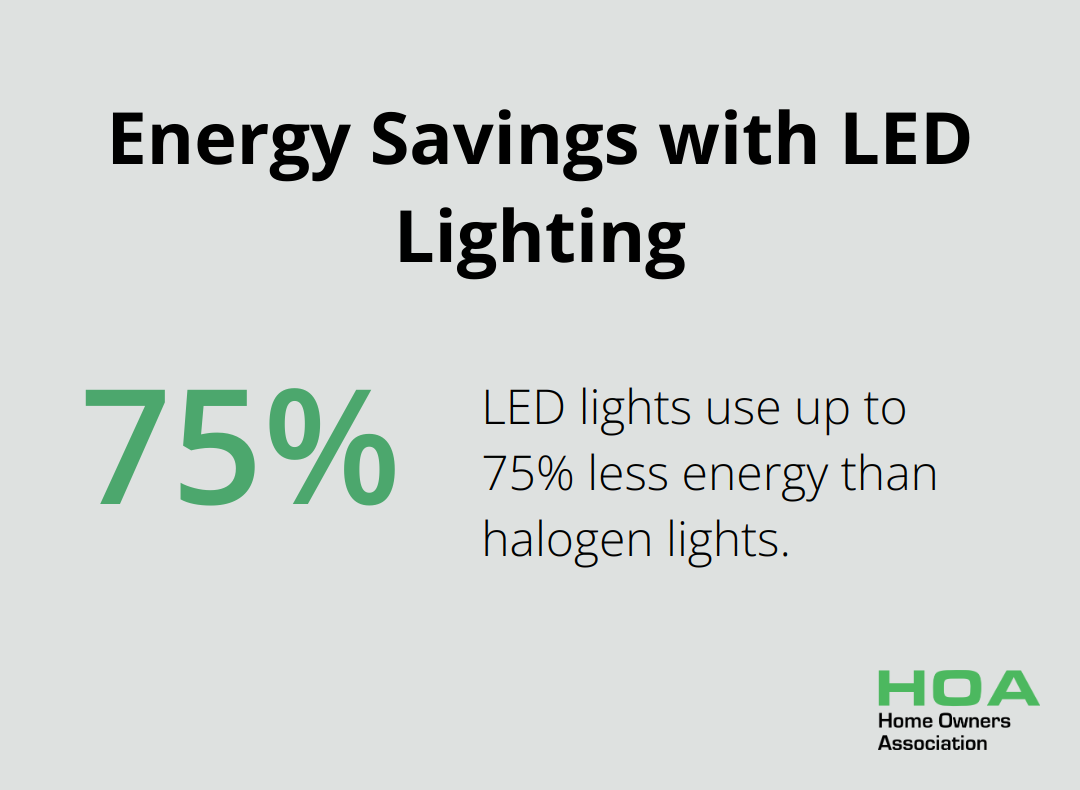
Improve Insulation and Windows
Proper insulation maintains comfortable temperatures and reduces energy waste. The Australian Building Codes Board recommends R-values (a measure of thermal resistance) between R2.5 and R6 for ceiling insulation, depending on your climate zone.
Double-glazed windows can regulate your home’s temperature and energy efficiency, and also reduce outside noise. While the upfront cost is higher, these windows can provide significant benefits. For a more budget-friendly alternative, consider applying window films (which can block up to 70% of solar heat gain).
Implement Water Conservation Strategies
A greywater system for garden irrigation effectively conserves water. These systems can recycle up to 70% of household wastewater for garden use. Check with your local council for regulations and permits before installation.
Installing water-efficient fixtures offers another simple yet effective strategy. The Water Efficiency Labelling and Standards (WELS) scheme helps consumers identify water-efficient products. A 3-star rated showerhead can save up to 20,000 litres of water per year for a family of four.
These practical tips allow Australian homeowners to significantly enhance the sustainability of their homes. Every small change contributes to a larger impact. As advancements in sustainable home technologies continue, the opportunities for improving our living spaces will only grow.
Final Thoughts
Australian sustainable homes have evolved significantly, incorporating innovative design features and cutting-edge technologies. These eco-friendly living spaces now include energy-efficient materials, solar power systems, water conservation techniques, and native landscaping. The latest trends in sustainable design further enhance environmental performance through passive solar principles, green roofs, smart home technology, and recycled materials.
Sustainable practices for Australian homeowners play a vital role in addressing environmental challenges and reducing carbon footprints. These homes offer long-term cost savings through reduced energy and water consumption while providing healthier living spaces. They also contribute to the overall well-being of occupants and help conserve valuable resources.
We at Home Owners Association encourage all homeowners to implement eco-friendly solutions in their homes. You can start with small changes like conducting an energy audit or upgrading to energy-efficient appliances (which can lead to significant improvements over time). Every action counts towards building a greener, more sustainable future for our communities and country.

